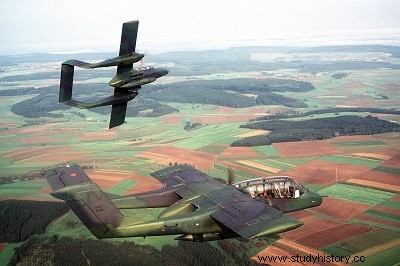
Features
North American (Rockwell) OV-10D Type:anti-guerrilla warfare and night surveillance aircraft.
Engines :two 776 kW (1,040 hp) Garrett T76-G-420/421 turboprop engines.
Performance
maximum speed at sea level , 463 km/h;
practical ceiling , 9,100 m;
combat range with maximum offensive load , 367 km.
Weight :empty, 3,125 kg; maximum take-off, 6,550 kg.
Dimensions
wingspan , 12.19m;
length , 13.41m;
height, 4.62m;
wing area , 27.03 m2.
Armament :5 attachment points capable of receiving an offensive load of 1,625 kg which can include various types of armaments (bombs, cannons, machine guns and missiles); two intrados pylons that can each support a load (bombs, fuel tanks or Sidewinder missiles) of 270 kg.
Designed in response to a US Marine Corps specification for an armed light reconnaissance aircraft, the North American NA-300 was contracted for seven YOV-10A prototypes in 1964 (the first of these took to the air on July 16, 1965). Comprising a very streamlined two-seater piloting nacelle, the aircraft had a high wing to which were attached - in the extension of the nacelles of the two turboprops - two fuselage beams which ended in a twin-derived tailplane; the two main elements of the tricycle landing gear retracted into the engine nacelles. For comparison purposes, one prototype was equipped with two Pratt &Whitney YT74-CP-8/10 turboprops and the other six with two Garrett T76-G-6/8 of 447 kW (600 hp).
The production OV-10A Bronco had a wingspan of which was increased by 3.05 m compared to that of the prototype and was equipped with two more powerful T76-G-10/12. The first copy left the ground on August 6, 1967, and 114 aircraft were to be built for the US Marine Corps. For its part, the US Air Force had to take into account a batch of 157 OV-10A that it used in operations in Vietnam from 1968. As part of the "Pave Nail" program, 15
these machines were fitted with special equipment allowing the localization and designation of targets at night. Other versions developed included the OV-10B, a model intended for towing targets for firing tests and supplied in six units to the Federal Republic of Germany, and the OV-10B(Z), identical to the previous one, but fitted with a booster rocket engine. OV-10As were also supplied to Indonesia (16 units), Thailand (40 units) and Venezuela (16 units) under the respective designations of OV-10F, OV-10C and OV-10E. In addition, the US Air Force transferred six of its OV-10As to the Royal Moroccan Air Force.
